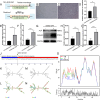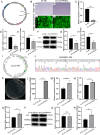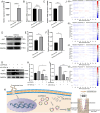CircPRKD3/miR-6783-3p responds to mechanical force to facilitate the osteogenesis of stretched periodontal ligament stem cells
- PMID: 38649946
- PMCID: PMC11036753
- DOI: 10.1186/s13018-024-04727-7
CircPRKD3/miR-6783-3p responds to mechanical force to facilitate the osteogenesis of stretched periodontal ligament stem cells
Abstract
Background: The mechanotransduction mechanisms by which cells regulate tissue remodeling are not fully deciphered. Circular RNAs (circRNAs) are crucial to various physiological processes, including cell cycle, differentiation, and polarization. However, the effects of mechanical force on circRNAs and the role of circRNAs in the mechanobiology of differentiation and remodeling in stretched periodontal ligament stem cells (PDLSCs) remain unclear. This article aims to explore the osteogenic function of mechanically sensitive circular RNA protein kinase D3 (circPRKD3) and elucidate its underlying mechanotransduction mechanism.
Materials and methods: PDLSCs were elongated with 8% stretch at 0.5 Hz for 24 h using the Flexcell® FX-6000™ Tension System. CircPRKD3 was knockdown or overexpressed with lentiviral constructs or plasmids. The downstream molecules of circPRKD3 were predicted by bioinformatics analysis. The osteogenic effect of related molecules was evaluated by quantitative real-time PCR (qRT-PCR) and western blot.
Results: Mechanical force enhanced the osteogenesis of PDLSCs and increased the expression of circPRKD3. Knockdown of circPRKD3 hindered PDLSCs from osteogenesis under mechanical force, while overexpression of circPRKD3 promoted the early osteogenesis process of PDLSCs. With bioinformatics analysis and multiple software predictions, we identified hsa-miR-6783-3p could act as the sponge of circPRKD3 to indirectly regulate osteogenic differentiation of mechanically stimulated PDLSCs.
Conclusions: Our results first suggested that both circPRKD3 and hsa-miR-6783-3p could enhance osteogenesis of stretched PDLSCs. Furthermore, hsa-miR-6783-3p could sponge circPRKD3 to indirectly regulate RUNX2 during the periodontal tissue remodeling process in orthodontic treatment.
Keywords: CircPRKD3; Mechanical force; PDLSCs; ceRNAs; miR-6783-3p.
© 2024. The Author(s).
Conflict of interest statement
The authors declare no competing interests.
Figures





Similar articles
-
Circ-SPATA13 regulates the osteogenic differentiation of human periodontal ligament stem cells through the miR-485-5p_R + 1/BMP7 axis.Cell Signal. 2025 Mar;127:111561. doi: 10.1016/j.cellsig.2024.111561. Epub 2024 Dec 10. Cell Signal. 2025. PMID: 39667547
-
The mechanism of lncRNA MALAT1 targeting the miR-124-3p/IGF2BP1 axis to regulate osteogenic differentiation of periodontal ligament stem cells.Clin Oral Investig. 2024 Mar 16;28(4):219. doi: 10.1007/s00784-024-05616-3. Clin Oral Investig. 2024. PMID: 38492123
-
LRP6/filamentous-actin signaling facilitates osteogenic commitment in mechanically induced periodontal ligament stem cells.Cell Mol Biol Lett. 2023 Jan 24;28(1):7. doi: 10.1186/s11658-023-00420-5. Cell Mol Biol Lett. 2023. PMID: 36694134 Free PMC article.
-
Circular RNA-Mediated Regulation of Oral Tissue-Derived Stem Cell Differentiation: Implications for Oral Medicine and Orthodontic Applications.Stem Cell Rev Rep. 2024 Apr;20(3):656-671. doi: 10.1007/s12015-024-10683-w. Epub 2024 Jan 27. Stem Cell Rev Rep. 2024. PMID: 38279054 Free PMC article. Review.
-
Non-coding RNAs Function in Periodontal Ligament Stem Cells.Stem Cell Rev Rep. 2024 Aug;20(6):1521-1531. doi: 10.1007/s12015-024-10731-5. Epub 2024 Jun 7. Stem Cell Rev Rep. 2024. PMID: 38848014 Review.
Cited by
-
Noncoding RNAs in periodontitis: Progress and perspectives (Review).Int J Mol Med. 2025 Nov;56(5):166. doi: 10.3892/ijmm.2025.5607. Epub 2025 Aug 14. Int J Mol Med. 2025. PMID: 40808350 Free PMC article. Review.
-
The circ_0054633/miR-590-3p/RUNX2 positive feedback loop promotes the osteogenic differentiation of BMSCs.Stem Cell Res Ther. 2025 Jul 1;16(1):325. doi: 10.1186/s13287-025-04450-y. Stem Cell Res Ther. 2025. PMID: 40597390 Free PMC article.
References
-
- Liu M, Zhang H, Li Y, Wang S. Noncoding RNAs interplay in Ovarian Cancer Therapy and Drug Resistance. Cancer biotherapy & radiopharmaceuticals; 2022. - PubMed
MeSH terms
Substances
Grants and funding
LinkOut - more resources
Full Text Sources
Medical

